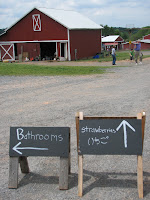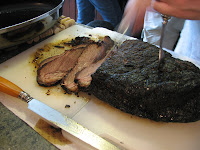To cap off the week of strawberry entries, I'm pleased to have a guest posting from my friend Andrea. Here is her take on our recent berry-picking excursion with a delicious recipe, too.
I watched the movie Bottleshock the other night, about the beginnings of the Napa Valley wine industry. The winemakers and vineyard owners were startled that the British, Francophile wine snob (played by Alan Rickman) was willing to pay for tastings.
I imagine it was sort of similar the first time a farmer opened his fields for a U-pick operation. "Really? People would pay me, and do the labor? City folk, no less? Sure. Who'd fall for that?"
Fine, I'm a sucker.
But I'm a sucker snacking on some really yummy strawberry bread...
This recipe is adapted from Everyday Food (http://www.marthastewart.com/recipe/strawberry-bread). Yes, Everyday Food. Perhaps this is evidence that Martha Stewart is not, in fact, the devil? (Ok, and how awesome is it that the favicon on that site is a little a picture of her face? I mean, not even Oprah tries to pull that off!)
Strawberry Bread
(makes 1 loaf of about 10 decent-sized slices)
I imagine it was sort of similar the first time a farmer opened his fields for a U-pick operation. "Really? People would pay me, and do the labor? City folk, no less? Sure. Who'd fall for that?"
Fine, I'm a sucker.
But I'm a sucker snacking on some really yummy strawberry bread...
This recipe is adapted from Everyday Food (http://www.marthastewart.com/recipe/strawberry-bread). Yes, Everyday Food. Perhaps this is evidence that Martha Stewart is not, in fact, the devil? (Ok, and how awesome is it that the favicon on that site is a little a picture of her face? I mean, not even Oprah tries to pull that off!)
Strawberry Bread
(makes 1 loaf of about 10 decent-sized slices)
Cooking spray
5 tablespoons unsalted butter, softened
2 cups strawberries, rinsed, hulled, quartered, and mashed
1 3/4 cups all-purpose flour
1 teaspoon baking soda
1/2 teaspoon ground cinnamon or baking/pumpkin pie spice
1/4 teaspoon baking powder
1/4 teaspoon salt
slightly less than 1 cup sugar
2 large eggs
1/3 cup water
5 tablespoons unsalted butter, softened
2 cups strawberries, rinsed, hulled, quartered, and mashed
1 3/4 cups all-purpose flour
1 teaspoon baking soda
1/2 teaspoon ground cinnamon or baking/pumpkin pie spice
1/4 teaspoon baking powder
1/4 teaspoon salt
slightly less than 1 cup sugar
2 large eggs
1/3 cup water
Preheat oven to 350 degrees. Coat an 8-by-4-inch loaf pan with cooking spray.
In a small saucepan, bring strawberries to a boil over medium heat. Cook, stirring, 1 minute. Set aside and let cool.
In a medium bowl, whisk together flour, baking soda, cinnamon, baking powder, and salt; set aside.
With an electric mixer, cream butter, sugar, and eggs in a mixing bowl until light and fluffy. Add flour mixture alternately with water, beginning and ending with flour.
Fold in reserved strawberries.
With an electric mixer, cream butter, sugar, and eggs in a mixing bowl until light and fluffy. Add flour mixture alternately with water, beginning and ending with flour.
Fold in reserved strawberries.



























































